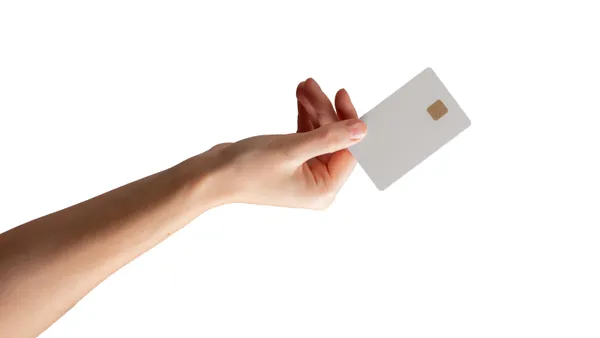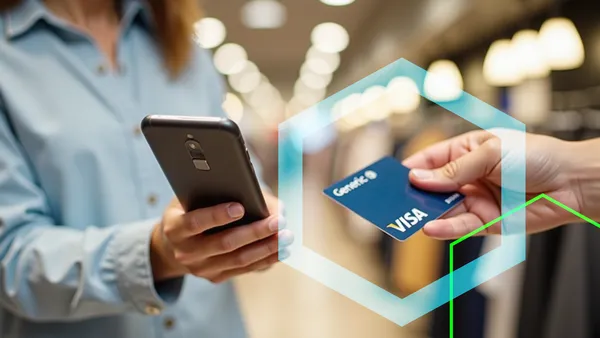Consumers' adoption of contactless and digital payments methods has opened new doors for more technologically advanced alternative modes of payments.
U.S. consumers are gaining some acceptance of wearable payments devices like rings and watches as, well as connected cars and smart home devices, according to a recent research report by Aite Group. Meanwhile, implanted payments devices have yet to catch on.
“Wearable devices are the most readily available option, and will likely continue to grow as consumers become more comfortable making non-card contactless payments,” Aite analyst and research author David Shipper said in an email. “Connected cars will likely have the highest regulatory and self-imposed hurdles because driver distraction is a huge concern. Some connected car functionality will have to wait until vehicles become more autonomous.”
Wearable payments technology
Aite surveyed 383 U.S. consumers, alongside bank and credit union executives, global software providers, payment device-makers and car manufacturers.
The wearable devices include smart watches, payment rings, bands and cufflinks which have near-field communication (NFC) chips that enable payments. Some 34% of consumers were "extremely interested" or "very interested" in using a wearable payment device to initiate payments, while 33% were "somewhat interested" and 2% were currently using wearable technology, the Aite survey results in the report showed. The study said that 31% of the consumer respondents were "not interested" in the technology.
VivoKey Technologies manufactures implant chip technology and plans on launching an NFC-enabled payment ring in Q4 2021, the company's CEO, Amal Graafstra, said in an interview.
“Our NFC-enabled payment ring would be made of a ceramic material along with a NFC chip and will have major card networks like Visa and Mastercard on it, following all their safety protocols,” Graafstra said. “We have been in touch with many financial institutions that want to offer the product to their customers post launch.”
Payments giant Visa launched its payments ring during the 2016 Summer Olympics in Rio de Janeiro, offering it for use by some athletes.
Visa's token technology replaces sensitive payment information, such as the 16-digit account number, with a unique digital code that can be used to process payments without exposing account details.
NFC-enabled smartwatches are another form of wearable payment device being adopted at a fast clip, according to the report. Apple has enabled its customers to initiate payment through Apple watches. The company generated $15.8 billion in revenue from Apple Watch sales in Q1 2021, an all time-quarter high, CEO Tim Cook said during its Q1 2021 earnings call.
The Cupertino, Calif.-based tech company is expanding its services in the contactless and digital payments space and is “very bullish” on consumer adoption, Cook said during its Q4 2020 earnings call.
Connected car payments technology
Connected car payments technology is also gaining traction as Google, Apple, Amazon and Fiserv develop payment options in smart and autonomous vehicles, the report said.
“It is projected that 70% of global new passenger vehicles will be internet-connected by 2023,” the report stated. “At least 17 major global car manufacturers are developing or have developed connected car payment capabilities.”
Thirty-four percent of consumers are "extremely" or "very" interested in using connected car payment technology, while 30% are "somewhat" interested, but only 1% currently use the technology to initiate payments from their cars. Some 34% of the respondents were not interested in the connected car tech.
“There is a lot of excitement around the future of connected car payments as in-vehicle systems continue developing, and as vehicles become more autonomous,” Shipper said. “Connected car payments can be integrated into almost any activity that requires a payment from the vehicle (i.e., pay for parking, pay for grocery and food pickup, pay for gas or a vehicle charge, etc.)”
Smart Home Devices
With people spending a majority of their time at home, that's the "ideal place to integrate fast and simple payment capabilities," the report said.
Smart home devices like Apple’s HomePod, Google Home and Alexa by Amazon are able to make payments.
“These devices use voice recognition to assure that only authorized users can make payments and purchases,” Shipper said.
About 90 million U.S. adults, 35% of the population, owned a smart speaker device in 2021, compared to about 47 million in 2018, according to a survey by the industry trade publication Voicebot.
Amazon’s Alexa’s “speech recognition capabilities, the intelligence behind it are getting smarter,” as the company plans on adding more features to the smart device, Amazon Investor Relations Head David Fildes said during Q1 2021 earnings call.
The Aite survey showed that 37% of the respondents were "extremely" or "very" interested in smart home devices making payments while 30% were "somewhat" interested and 3% were already using them for payments. Still, 30% of the respondents were "not interested" in the connected home payment tech, according to the report.
Chip Implant payments technology
Companies like VivoKey Tech offer small chips made of “bio glass” which is usually inserted in a person's palm. Currently, the chips can be used to verify identity, initiate actions and web pages of mobile devices along with providing access to open doors, but payments via implant chips have a long hill battle to fight.
“The chip has to be encoded in accordance with the major card network” for processing the payment, Graafstra said. Our company has approached Visa and Mastercard about the idea, but they rejected it.
Consumer adoption might also be a hurdle, as many consumers aren’t willing to get an implant, Shipper said in the email. Implant payments tech “is not for everyone,” he said, noting some respondents cited paranoia about being tracked, and religious reasons for not wanting an implant.
Bank executives have mixed opinions about the use of implanted tech as they expect more functionality from the implant rather than just making payments. “If it can only do payments, then no. More than payments (e.g., unlock my computer, hold health records), then maybe," a bank service provider executive said in the report.
Graafstra has two implanted chips, one in each hand, that he uses for various reasons like accessing doors and identity verification.
“I have never encountered any problem...it usually takes a doctor to make a tiny incision to place the chip,” Graafstra said. “You can add multiple functionality to a chip reducing the need of removing it frequently.”
Despite consumer concerns, nearly 41% of respondents in the Aite survey were "extremely," "very" or "somewhat" interested in using implant payments technology while the majority, 59% were "not interested," the report said. None said they had used an implant.











